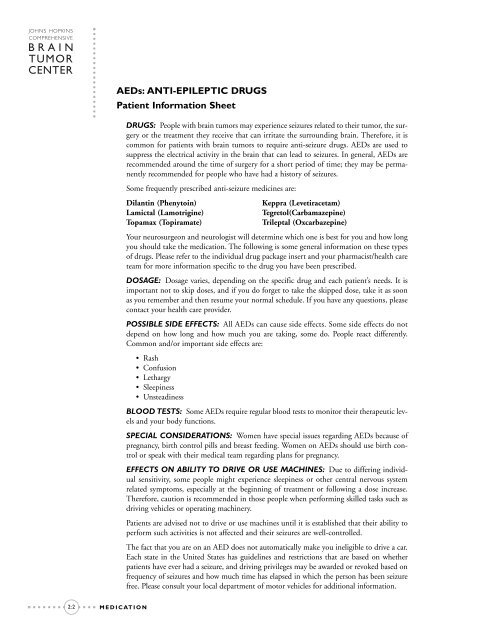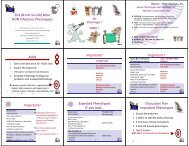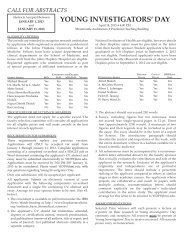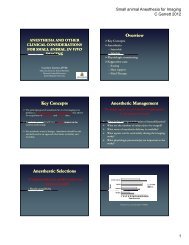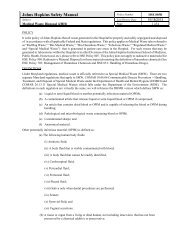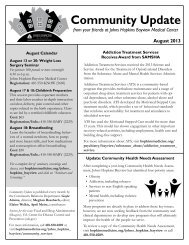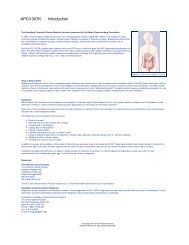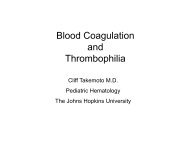Table of contents - Johns Hopkins Medical Institutions
Table of contents - Johns Hopkins Medical Institutions
Table of contents - Johns Hopkins Medical Institutions
Create successful ePaper yourself
Turn your PDF publications into a flip-book with our unique Google optimized e-Paper software.
2:2 MEDICATION<br />
AEDs: ANTI-EPILEPTIC DRUGS<br />
Patient Information Sheet<br />
DRUGS: People with brain tumors may experience seizures related to their tumor, the surgery<br />
or the treatment they receive that can irritate the surrounding brain. Therefore, it is<br />
common for patients with brain tumors to require anti-seizure drugs. AEDs are used to<br />
suppress the electrical activity in the brain that can lead to seizures. In general, AEDs are<br />
recommended around the time <strong>of</strong> surgery for a short period <strong>of</strong> time; they may be permanently<br />
recommended for people who have had a history <strong>of</strong> seizures.<br />
Some frequently prescribed anti-seizure medicines are:<br />
Dilantin (Phenytoin) Keppra (Levetiracetam)<br />
Lamictal (Lamotrigine) Tegretol(Carbamazepine)<br />
Topamax (Topiramate) Trileptal (Oxcarbazepine)<br />
Your neurosurgeon and neurologist will determine which one is best for you and how long<br />
you should take the medication. The following is some general information on these types<br />
<strong>of</strong> drugs. Please refer to the individual drug package insert and your pharmacist/health care<br />
team for more information specific to the drug you have been prescribed.<br />
DOSAGE: Dosage varies, depending on the specific drug and each patient’s needs. It is<br />
important not to skip doses, and if you do forget to take the skipped dose, take it as soon<br />
as you remember and then resume your normal schedule. If you have any questions, please<br />
contact your health care provider.<br />
POSSIBLE SIDE EFFECTS: All AEDs can cause side effects. Some side effects do not<br />
depend on how long and how much you are taking, some do. People react differently.<br />
Common and/or important side effects are:<br />
• Rash<br />
• Confusion<br />
• Lethargy<br />
• Sleepiness<br />
• Unsteadiness<br />
BLOOD TESTS: Some AEDs require regular blood tests to monitor their therapeutic levels<br />
and your body functions.<br />
SPECIAL CONSIDERATIONS: Women have special issues regarding AEDs because <strong>of</strong><br />
pregnancy, birth control pills and breast feeding. Women on AEDs should use birth control<br />
or speak with their medical team regarding plans for pregnancy.<br />
EFFECTS ON ABILITY TO DRIVE OR USE MACHINES: Due to differing individual<br />
sensitivity, some people might experience sleepiness or other central nervous system<br />
related symptoms, especially at the beginning <strong>of</strong> treatment or following a dose increase.<br />
Therefore, caution is recommended in those people when performing skilled tasks such as<br />
driving vehicles or operating machinery.<br />
Patients are advised not to drive or use machines until it is established that their ability to<br />
perform such activities is not affected and their seizures are well-controlled.<br />
The fact that you are on an AED does not automatically make you ineligible to drive a car.<br />
Each state in the United States has guidelines and restrictions that are based on whether<br />
patients have ever had a seizure, and driving privileges may be awarded or revoked based on<br />
frequency <strong>of</strong> seizures and how much time has elapsed in which the person has been seizure<br />
free. Please consult your local department <strong>of</strong> motor vehicles for additional information.


